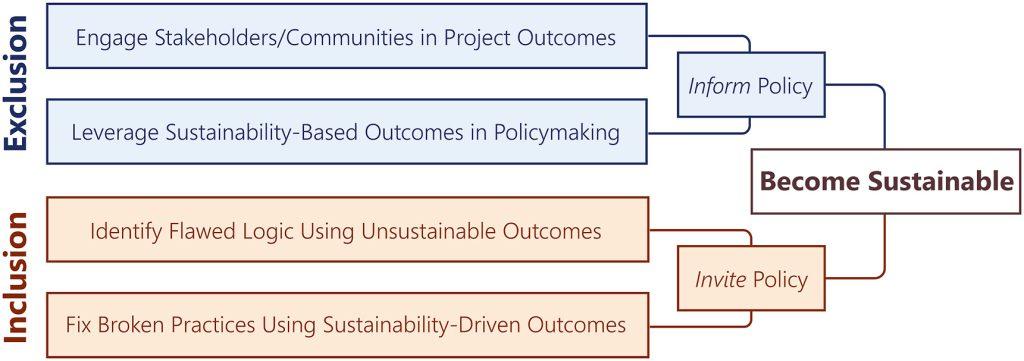UF/IFAS researchers, with colleagues in the U.S. government and another land grant university, are proposing a new way to approach environmental sustainability. The team’s proposal comes from synthesizing 21 research articles that comprise a special issue of the Journal of Environmental Management. Their takeaway is that the role of policy is disconnected from major sustainability efforts in democratic societies with capitalistic economies, and they have developed an example sustainability model as a result.
Sam Smidt, assistant professor of watershed science in the UF/IFAS department of soil, water, and ecosystem sciences, was a guest editor for the special journal issue. He discusses what they learned from the publication and explains their proposed framework.
The virtual special issue (VSI) is titled Building an Applied Sustainability Model Through Integrated Environmental, Economic, Social, and Political Case Studies. The submission solicitation to authors noted that “a notable gap exists between environmental sustainability discourse and on-the-ground applications.” What was the response like from the submissions you received?
We received 61 article submissions, and 21 studies were accepted for publication in the VSI. We asked for contributions to emphasize the integration of society, the environment, the economy, and regulatory governmental policy, as these are largely the components most involved in environmental sustainability. We received articles covering a very wide range of topics like watershed management, healthy lifestyles, waste and its re-use, and green engineering. We ultimately used the common threads between these studies to develop a harmonized sustainability model rooted in applied contexts.
You and your guest editor colleagues synthesized the VSI’s 21 articles and found policy was lacking when it comes to developing sustainability frameworks. How so?
Yes. Sustainability is often viewed as the successful balancing of the 3 P’s: People (society), Planet (environment), and Profit (business). But what is lacking is the role of government, which can both facilitate or inhibit this balancing act. I have always found it interesting that we are yet to include Policy as a 4th P, even though it plays a vital sustainability role. Clearly, there is recognition that policy is important as there is an ongoing push for researchers to work with policymakers or have their work inform policymakers. In this paper, we point out that most researchers argue they can inform policy, or policy can inform them, but these are yet to be integrated into an environmental sustainability framework. We try to bring policy earlier into the conversation by arguing that sustainability cannot be achieved until these four pillars (people, planet, profit, policy) are balanced.

This gap exists within environmental sustainability related to policy’s place in the discussion, but you also think there is a disconnect between economic growth and political harmony.
We point out that adding policy to sustainability is not a simple task because the objective of political sustainability does not align with the objective of economic sustainability. This disconnect must be resolved before sustainability as a discipline can make any real progress. We define economic sustainability as where supply meets demand (no shortage or excess; economically stable). But politically, this is problematic. Imagine if there was just enough food (supply) for every person (demand) in a community. This would be an extremely risky place to be politically since every day there would be a food shortage risk. As a result, political sustainability is where supply greatly exceeds demand (food is abundant, there is no political risk), but this remains economically illogical. The big question is then how can we design a model where both political and economic objectives align? In addition, capitalist economies require constant growth, which inherently includes greater access to resources. So, while policymakers are working to keep the economy stable with greater access to resources, they are also working to conserve those resources to a level where quantity/quality is significantly greater than demand. We describe this as a political paradox for environmental sustainability, as favorable economic conditions lead to political risk, but favorable political conditions lead to economic risk. The result is no real sustainability target for policymakers.
What are some of the benefits of this framework you’re proposing? What makes it different?
In this article, we propose a harmonized sustainability model constructed out of the VSI takeaways. We outline several benefits to this type of economically and politically aligned model, but to list a few:
- This model is a proactive policy approach while other models require regulatory policies to be reactive. A reactive policy approach is inadequate for addressing a range of sustainability-related problems, especially those that can become irreversible in nature like endangered species loss, nuclear waste, or loss of indigenous communities and their knowledge.
- This model allows environmental policy to generate economic activity. We believe policymakers can act in a way that accelerates wealth creation because the socio-environmental harmony objective is being upheld. If political and economic objectives are aligned and centered around political harmony, economic activity is free to perform in a way most optimal for economic growth.
- Unlike other sustainability models, a harmonized model can also function in reverse – for the waste or disposal of resources. Most sustainability models capture the consumption of new resources but rarely consider the waste component, or vice versa. Having one model that considers both an upper and lower threshold in sustainability fully bounds the range in which economic activity is free to explore environmental resources without interruption, a characteristic lacking in other sustainability models.
Why is this proposed framework important?
Environmental sustainability has become a ubiquitous societal goal, but this goal has largely stemmed from sustainability models that formed decades ago out of a field with little known origin. The reality is the driving sustainability discussions simply do not hold up in applied contexts like agriculture, urbanization, and water resources management. This model provides a new lens for viewing and discussing environmental sustainability in a way that can hopefully cause others to rethink their approaches, especially in applied contexts.
You can read the full article here: https://www.sciencedirect.com/science/article/pii/S0301479722008878?dgcid=author
 2
2
